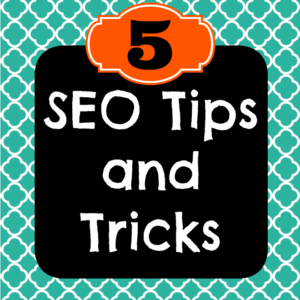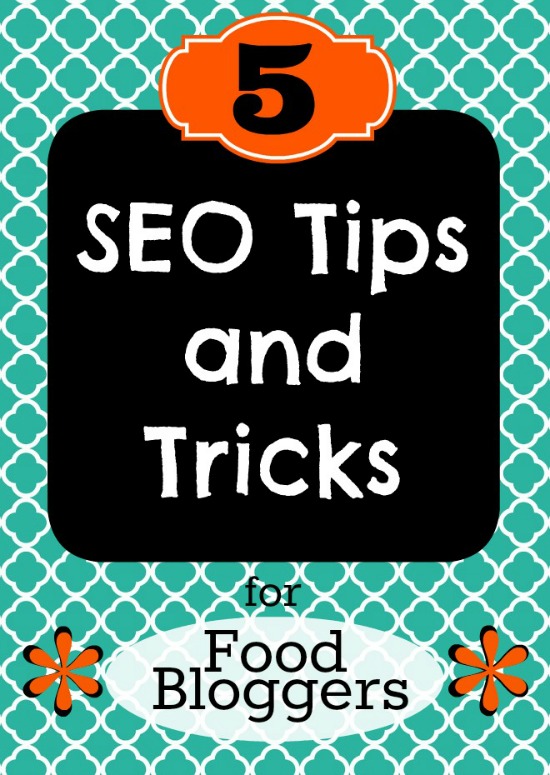Apologies to my regular readers. I promise more calorie -laden treats will be coming your way in my next post, but this one is geared toward my food-blogging buddies around the interwebs.
 SEO (Search Engine Optimization) just sounds hard, doesn’t it? I’ve been totally intimidated by it for years.
SEO (Search Engine Optimization) just sounds hard, doesn’t it? I’ve been totally intimidated by it for years.
I finally decided one day to buckle down, and just learn it. I told myself, this is my craft. This is my job. And it’s ridiculous for me to NOT know what I am doing.
I started by studying and studying and studying. I read everything I could get my hands on. (There’s TONS of free info online.) I started experimenting and using my tracking tools.
I purchased programs, got a coach, and even got some specific advice tailored towards me. Am I now an SEO expert? FAR from it. But I have at least learned not to be intimidated by it.
I will tell you that although I get a lot of traffic from Pinterest, my very most popular post gets more than double the traffic of my second most popular post, and about 75% of the traffic to that post is organic traffic from Google searches.
For all you food bloggers out there, here a few general things I have learned that have helped me gain some confidence and some traffic.
1. Keyword Research – you get what you pay for.
There are no good keyword research tools that are free. There just aren’t. If you want good keywords, phrases people will actually be searching for, you need to pay for it. A good tool will tell you three things… 1) What the keyword phrases are. 2) Number of monthly searches for that keyword phrase. 3) How much competition there is for that keyword phrase.
Here’s another related truth… the AdWords Keyword Research tool is not really a keyword research tool. It doesn’t tell you what competition there is for a given keyword, only what competition there is for BIDDING on a keyword phrase for ad space. This is all about advertising. It might be fun to use it to discover new keywords, but it will never reliably tell you how much competition is out there, and that’s a fact you need to know.
The tool I use is WordTracker. You can purchase a monthly subscription HERE, or do like me and use BizXpress Tools HERE. It’s cheaper this way, and I like the way the tool works inside BizXpress better. You will have to pay an annual fee to use Biz Express, plus purchase the WordTracker credits, but they last a long time, and they are worth the price.
If you want to start with some free tactics, you might check out this video which will give you some ideas about how to do some keyword research for free.
2. Think like a search engine user.
No one is searching for “Aunt Betty’s Famous Apple Pie,” or “My Husband’s Favorite Meal.” If you want to take advantage of SEO, think like someone who is on a search engine, searching for something. Titles should clearly reflect what is in the food, without being 12-word-long specific.
For example, let’s say you made a gorgeous apple pecan pie with a pecan and brown sugar crumb topping and a warm caramel sauce. You could title the post “Apple Pie with Pecan Brown Sugar Crumb Topping and Warm Caramel Sauce Drizzle” but that would be a bit intense. And annoying. You lost your readers halfway through the title and they haven’t even started the post yet. Plus, no one is searching for that.
You could call it “Aunt Betty’s Famous Apple Pecan Pie” but that isn’t specific enough, and no one cares about your Aunt Betty.
No offense to Aunt Betty. I’m sure she is a lovely person.
You could just go with “Apple Pie” but it is SUCH a broad phrase, and there are already approximately 100 million apple pie recipes online, it is way too much to compete with.
The goal is to find the happy medium. Something that tells you enough without smacking you over the head with it. This is where the keyword research can really come in handy. I would probably prefer something like “Apple Pie with Pecan Crumble” or “Pecan Topped Apple Pie” to make it clear and intriguing.
Just for laughs, I punched the words “apple pie” into my keyword tool, and I found some interesting results. The phrase “baked apple pie” has an average of 421 searches a month, and there are 519 pages optimized for this term. Do I want to compete with 519 pages? No I don’t. On the other hand, “crumble top apple pie” has 330 searches a month and just 1 page optimized for the term. Compete with ONE page? This is much better. I want as many of those 330 searches a month as I can get.
Therefore, I’m guessing my number one title choice would be “Pecan Crumble Top Apple Pie.” It’s clear, it’s concise, and it will bring me some good organic traffic.
And don’t forget to check on how your titles and keywords are performing by checking Google’s Webmaster Tools. It only shows info for the past 90 days, but it’s good useful info.

3. Backlinks are your friends.
Having other websites, especially good ones, link to your content is a very very good thing for you. This tells search engines that other people think your content is worthy of sharing with their audiences.
As a food blogger, one of the best and easiest ways I have found of creating backlinks to is get your stuff into round ups on other blogs. I belong to this Facebook group that makes this process super duper easy. People in the group can ask for certain types of recipes for round ups, and bloggers can drop links to their content in there. It is no guarantee that someone will use your recipe, but it does make it more likely. Otherwise, we are left to search Pinterest or FoodGawker for good stuff. (You can follow the link and ask to join, but we aware that the admins are a little fussy about who is accepted. No spammers allowed!)
And speaking of FoodGawker… food photo submission sites also provide some backlinks, and some traffic. Even if the traffic is not that amazing, I recommend that you still submit content to these sites just to get some links. Some of my favorites, besides FoodGawker are: Tastespotting, Tasteologie, YumGoggle, DessertStalking, DishFolio, Food Foto Gallery and Cookie Hound. One link on these sites is not that useful, but many links is, so keep on submitting.
4. Don’t forget social.
Social networks can be great for driving traffic, but remember that social validation looks good to the search engines too. They figure that 100,000 Pinterest or Facebook fans can’t be wrong.
Make it easy for your readers to share your content on their social channel of choice, and encourage them to do so. Find ways to make social a real and relevant way for people to find you. Pins, likes, +1’s, stumbles, and shares are all signals that your content is quality, useful, and something people want to see.
Love this article? Share it on Pinterest!
5. Get a coach and keep learning.
One thing we know about the digital world we live in is that it is constantly changing. The search engines, social media networks, and audience all make changes every week. The tips I shared here today will most likely not be relevant a few years from now. It is important to keep learning and growing and being open to change.
I’ll be honest with you. SEO is one of those things I have had a hard time understanding. It took me a LOT of studying to get the hang of it, and I am still working to understand it better. The most useful tool I have come across is this 21-Day SEO Challenge from Blogging Concentrated.
In fact, almost everything on Blogging Concentrated has been amazingly useful to me. There is a course about Keyword Mapping that I love, and if you join the BC Prime Membership program, you will get tons of new content all the time, including traffic tips, a program about making video, business book reviews, CEO insights, social media tips, and so forth.
I’ve also found lots of useful information on sites like Backlinko and ProBlogger. It’s good to keep reading and learning.
Bonus Tip: don’t optimize everything
Not every post on your site needs to be optimized for search engines. Some are just easier to get to once people have already found you. Focus on the best stuff, and link to everything else in a way that makes sense.
And don’t be intimidated by SEO. You can do this. I believe in you!
Want more? Check out these other thoughts on food blogging!





These are great tips, Jen. Thanks so much for sharing them with us. Every time someone says SEO to me, my eyes automatically start glazing over even though I know how important it is.
I know that feeling! I know it all too well.
Great tips, Jen. I took a SEO course in around 2000, and things have moved on sooooo much since then – some principals are the same though.
The whole post title thing I really need to work on. I’m either too vague or too specific. I can’t seem to find that happy medium. I’m also intrigued about the Facebook group you linked to, but must be a secret group so I can’t see anything (says content not available. I’d love an invite though if you’re able too?
I’m using Google Trends and Google Keyword Tool for post title ideas, but they only seem good if you already know your post title. For example, the different between ‘St. Patricks’s Day’ and ‘St Patrick’s Day’ (without the dot after St).
It’s definitely overwhelming when you think everything us bloggers plan and do though. I’m sure people think we just write everything up, publish it and that’s that!
This post is brilliant and perfect for people who do not understand the first step to SEO. Thank you!
Thanks so much for this information! I am just getting started with the SEO on my blog. Your tips are very useful.
Great article. I’d like to recommend SEO Post Content Links Plugin. It’s an automatic SEO for websites and fully supports internal linking for all languages.
Useful tips!!
Thank you so much! I understand SEO from another website I built (on a completely different topic), but I just started a food blog and I gotta say- I feel like I’m starting over again. Learning the ins and outs of the ‘food blog’ world has been a whole new ballgame! So much to learn, so much to do!!! This was a super useful post/resource, just bookmarked it. Gonna submit to a few of those food photo submission sites this week, thank you! Wish me luck! 😉
hi Jen, I really like your point on SEO that think like Search Enginer user. While working on myself on backlink i have learned a lot as well. Thanks
Thank you so much for this. I want to have a food section for my blog and this really helped me.
Hi Jen,
so amazing SEO Tips for Food Bloggers. Interesting and informative.